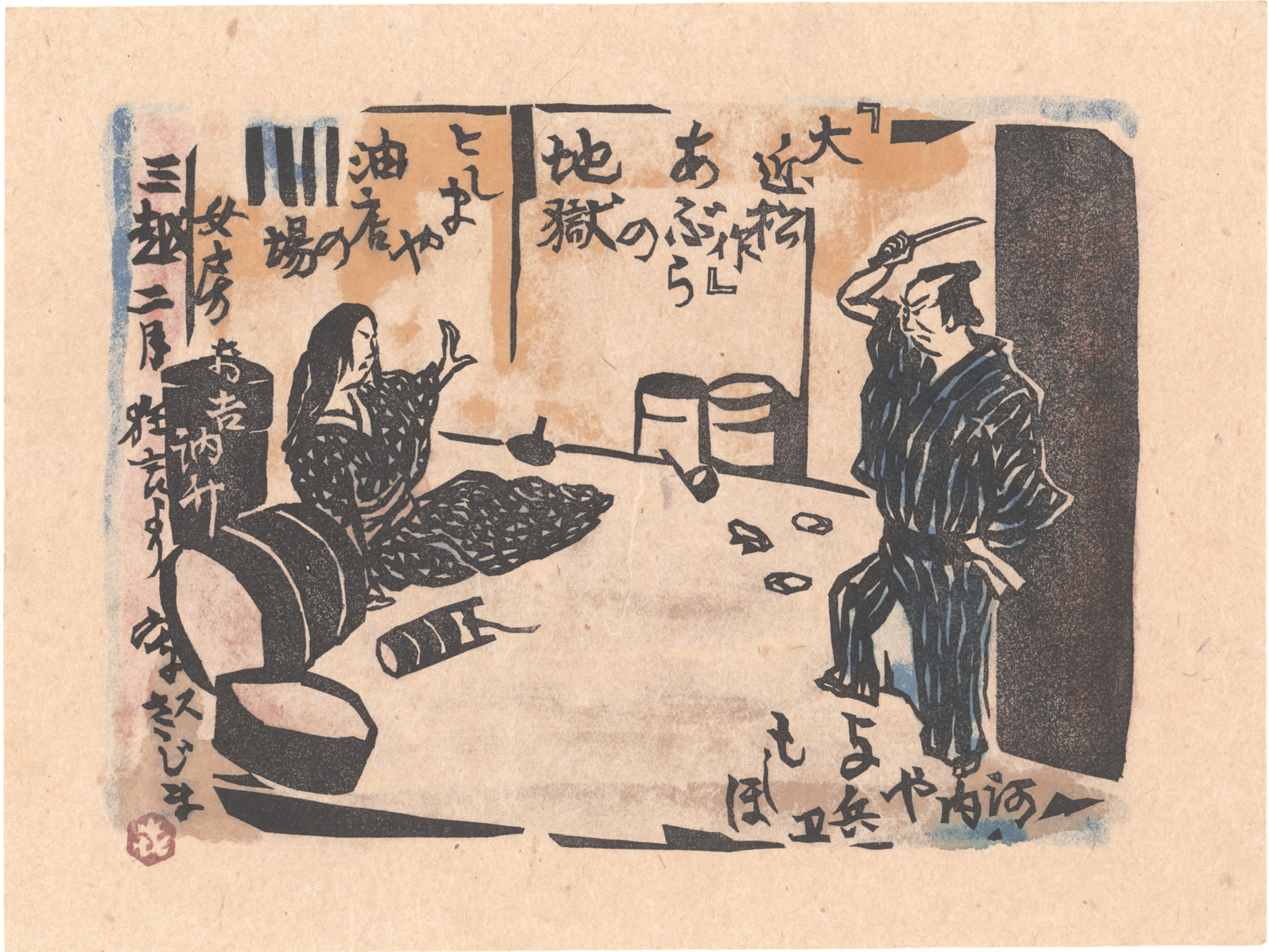About This Print
This print depicts a scene in the third act from the play Onna Goroshi Abura no Jigyoku, in which Kawachiya Yohei, played by Nakamura Moshio IV (1909-1988), is about to slay Okichi, the wife of the proprietor of the Teshimaya oil store, played by Sawamura Tosshō IV (1908-1975). The play was performed at the Mitsukoshi Theater (三越劇場 Mitsukoshi gekijō) in February 1949. The print is one of an unknown number of prints created by Sasajima for the 1948 and 1949 kabuki seasons at the Mitsukoshi Theater.For details of this performance please visit the website "Kabuki on the web" at:
Inscriptions
(note: my thanks to Lynn Katsumoto, Asian Art Historian, for her assistance in transcribing and translating the transcriptions)
top right: [大近松作] あぶらの地獄 - "Big Chikamatsu production" Abura no Jigokulower right: 河内や与兵 もしほ- Kawachiya Yohei Moshio [Nakamura Moshio IV]
upper left: としまや 油店の場 女房お吉 訥升 - Teshimaya abura ten no ba [Teshimiya oil shop scene]
女房お吉 訥升 Nyōbō [the wife] Okichi Tosshō [Sawamura Tosshō IV]
left edge: 三越二月 狂言 より 写スさゝじま- Mitsukoshi nigatsu kyōgen yori utsusu Sasajima [from the February Mitsukoshi performance, pictured by Sasajima]
Sasajima has hand-applied ink on the verso of this print to provide a subtle coloring when viewed from the front, a technique he learned from the artist Munakata Shiko (1903-1975).
1 Details on the performances during the Mitsukoshi Theater 1948 and 1949 kabuki seasons can be found at Kabuki on the Web http://www.kabuki.ne.jp/
Sasajima's Mitsukoshi Theater Prints
I have only seen general references to these small prints depicting various productions during the 1948 and 1949 kabuki seasons at the Mitsukoshi Theater. One reference appearing in Shizuya Fujikake's 1953 print survey book Japanese Wood-Block Prints, simply states "Since 1947, he [Sasajima] is producing a great many Kabuki prints in his unique, black and white style."1 [As can be seen by several of the prints in this collection, Sasajima also used subtle color in some of the prints, hand-applying ink to the print's verso.] Another reference notes that in 1948 (Shōwa 23), at the age of 42, Sasajima "produces Mitsukoshi kabuki prints, but the work affects his health and he suspends the activity after three years."2
1 Japanese Wood-block Prints, Shizuya Fujikake, Japan Travel Bureau, 1953, p. 173-174.
The Play - Onna Goroshi Arbura no Jigyoku
Source: Kabuki Encyclopedia, An English-Language Adaption of Kabuki Jiten, Samuel L. Leiter, Greenwood Press, 1979, p. 293.
Author: Chikamatsu Monzaemon
English title: The Woman Killer and the Hell of Oil
First Performed: July 1721 at the Takemoto-za, Osaka.
This play appears to be a dramatization of a true contemporary event.
Kawachiya Yohei of the Tenman oil shop takes advantage of the generosity of the ship's chief clerk, his stepfather Tokubei, and leads a dissipated life; he becomes hopelessly debauched and is punished by his mother, Osawa, by being disinherited. Yohei is at a loss as to how to pay back money that he has borrowed under false pretenses. He requests money from Okichi, wife of the Toshimaya oil shop owner; he robs and kills here when she refuses, and then flees. When, on the first anniversary of her death, he shows up looking as innocent as he can, he is arrested, because evidence has been obtained against him.
The scene when Tokubei and Osawa, fearing for their son, come separately to leave money with Okichi for Yohei and thus show their affection for his is outstanding. Another highlight is the gruesome murder scene. The playwright imbues Yohei with modern touches that are novelties for a Chikamatsu character.
The Mitsukoshi Theater
Source: Tokyo from Edo to Showa 1867-1989 : the Emergence of the World's Greatest City, Edward Seidensticker et al., Tuttle Pub., 2011.
The Mitsukoshi Theater played a significant role in the revival of kabuki after the damage inflicted to the major Tokyo kabuki theaters during WWII. "Ever since its rebuilding after the 1923 earthquake [Great Kantō Earthquake], Mitsukoshi had had an auditorium which it rented out for meetings and performances. The name was changed from Mitsukoshi Hall to Mitsukoshi Theater in 1947, at which time it became a full-fledged, full-time theater. In addition to providing another place for Kabuki, a somewhat more sumptuous and elegant one than the Tōkegi [the only major Kabuki theater to survive the WWII bombing], the Mitsukoshi Theater was very important in passing Kabuki on from an aging generation to an emerging one."
The theater was last used for kabuki in 1951, the year the Kabuki-za opened.
The Actors in the Print
For background on the actors see their respective entries in the article The Kabuki Actor on this site.
Print Details
| IHL Catalog | #1382 |
| Title | Nakamura Moshio IV and Sawamura Tosshō IV in Onna Goroshi Abura no Jigoku at the Mitsukoshi Theater |
| Series | Mitsukoshi Kabuki Hanga 三越歌舞伎版画 [untitled series of prints for the Mitsukoshi Theater 1948 and 1949 kabuki seasons] |
| Artist | Sasajima Kihei (1906-1993) |
| Signature | not signed |
| Seal |  |
| Publication Date | 1949 |
| Publisher | likely Mitsukoshi Gekijō or the artist |
| Carver | self-carved |
| Impression | excellent |
| Colors | excellent |
| Condition | good - minor handling/printing creases, mild toning, irregular margin right corer |
| Genre | sosaku hanga; kabuki-ga |
| Miscellaneous | |
| Format | |
| H x W Paper | 7 3/16 x 9 3/8 in. (18.3 x 23.8 cm) |
| H x W Image | 5 7/8 x 7 3/4 in. (14.9 x 19.79 cm) |
| Collections This Print | |
| Reference Literature |



